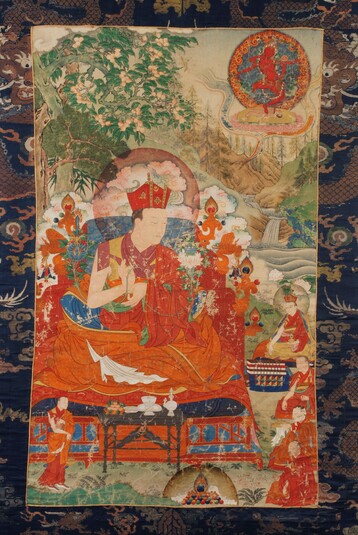
Item: Teacher (Lama) - Shamarpa 6, Mipam Chokyi Wangchug
| Origin Location | Eastern Tibet |
|---|---|
| Date Range | 1700 - 1799 |
| Lineages | Karma (Kagyu) and Buddhist |
| Material | Ground Mineral Pigment on Cotton |
| Collection | Rubin Museum of Art |
Mipam Chokyi Wangchug (1584-1630), 6th Shamar Incarnation of the Karma Kagyu (Kamtsang) Tradition of Tibetan Buddhism. Shamarpa is considered an emanation of Amitabha Buddha and known as the Red Hat Karmapa following after the Black Hat Karmapa. This composition is number 26 in a larger set of paintings depicting the abbreviated Mahamudra Lineage of the Karma Kagyu Tradition. (See the Karma Kagyu Lineage Sets Main Page and Outline Page).

Shamar Rinpoche is seated looking to the viewer's right. His hands are held in a teaching gesture while grasping the stems of two flower blossoms - a blue utpala supporting a sword on the proper right side and white lotus supporting a book on the left. The sword and book, typically the symbols of the deity Manjushri, indicate the qualities of wisdom and knowledge. Wearing a Tibetan style monastic shirt and the upper robe of a fully ordained monk, the lower body is wrapped with a meditation cloak. Atop the head he wears a red hat, gifted by the 3rd Karmapa, Rangjung Dorje (1284-1339), similar in design to that of the black hat of the Karmapas. The typical characteristics of the Shamarpa hat are 1) red in colour, 2) jewel emblem on the front and 3) the cloud motif at the sides trails to the back. Although these are the three standard characteristics there are many exceptions that appear in art. The one thing that can be said for sure is that the hat is red in colour.
Descending at the middle right are four Tibetan teachers situated one above the other. The first, wearing a red hat, is the 5th Gyaltsab, Dragpa Chogyang (1618-1658) wearing an orange coloured hat following the style of the black hat of the Karmapas and holding a long-life vase in the left hand. A low table and three Tibetan texts are placed in front. Below that is the 4th Drung, Surmang Drungpa Kunga Namgyal (17th century), holding a string of prayer beads, followed by Karma Chagme (1613-1678) holding a gold mandala offering plate. Below that is an unidentified final figure at the bottom right. Also, standing at the left side of the composition is an unidentified servant. The original set was likely commissioned in Tsurphu monastery in the 15th or 16th century and then later lineage figures added over time and other copies of the set created up into the 20th century. The identification of these figures is based on inscriptions and written explanations describing the composition for this set of paintings. (See the illustrated publication The Golden Garland of Kagyu Biographies by Situ Chokyi Jungne. Vol. 1, 2, 3. Vajra Vidya Institute Library, Varanasi, 2004).
The hat worn by the fifth Gyaltab is interesting as it has the double vajra motif at the front and the cloud trails also facing the front of the hat. Both of these design characteristics follow the model of the black hat of the Karmapa, however, the colour of the hat is more orange than red and there is a very clear divot or notch at the top of both side flaps. The divot is said to be a characteristic of the hat worn by the Tai Situ incarnations.
At the top right is the meditational deity, goddess of power, Kurukulla, red in colour, with one face and four hands holding a bow and arrow, hook and lasso, all composed of red utpala flowers. She is semi-wrathful in appearance and stands on the left leg atop a prone figure, sun disc, pink flower blossom, surrounded by the flames of pristine awareness fire. Red and blue flowers are generally identified as utpala - possibly an iris - and white flowers are usually identified as padma - lotus flower. The udumbara flower is sometimes depicted in art in association with Shakyamuni Buddha, the ashoka branch and flower with Maitreya and Marichi and the hollyhock in conjunction with Black Manjushri. The goddess Parnashavari holds a branch of medicinal leaves and fruit but the species of plant is not named.
"Culmination of the pristine awareness and compassion of all conquerors,
Well arising as the bliss-emptiness - Goddess of Power,
Controlling all beings of the three realms with a charming form;
Homage to the Dakini." (Nyingma liturgical verse).
There are numerous forms and lineages of Kurukulla arising from the Kriya and Anuttarayoga classes of tantra of the Sarma traditions and many forms from the 'Terma' (Revealed Treasure) traditions of the Nyingma School. In the Kriya tantras she is often portrayed, but not exclusively, as a red power emanation of Tara. However, most forms of red Tara are not Kurukulla. In Anuttarayoga, from the Hevajra and Vajrapanjara Tantras, she is a power emanation of Shri Hevajra. (See the Kurukulla Main Page and Kurukulla Outline Page).
Jeff Watt 1-2011
Collection of Rubin Museum of Art: Painting Gallery 4
Subject: Sword & Book (Teachers)
Painting Set: Karma Kagyu Lineage (Palpung Set 2)
Collection of RMA: Best of Collection 2
Collection of RMA: Best of Collection 3
Collection of RMA: Painting Masterworks Page
Collection of RMA: Persons Masterworks
Subject: Teacher Painting Page
Incarnation Lineage: Shamarpa Iconography
Incarnation Lineage: Shamarpa Main Page
Painting Set: Karma Kagyu Lineage (Sertreng, misc.)
Teacher: Shamar 6th, Chokyi Wangchug
Teacher: Shamarpa (Paintings)
Painting Style: Palpung Monastery (following Karma Gadri Style for Lineage Painting Sets)
Teacher: Shamarpa (Masterworks)




